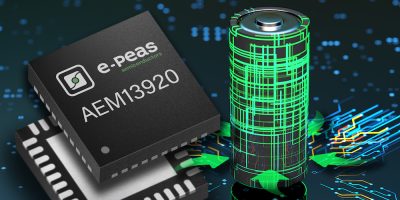Energy harvesting PMIC handles two independent energy sources simultaneously
The AEM13920 is the first power management IC (PMIC) from e-peas which can handle simultaneous inputs from two independent harvested energy sources. Typically, specialised PMICs are optimised for a single energy harvester.
It can maximise the energy harvested from any combination of two sources, including photovoltaic (PV) cells, a thermoelectric generator (TEG), RF energy harvester or pulsed (kinetic) energy sources.
The dual-source capability opens up design options for energy harvesting in small electronics devices such as remote controls, PC peripherals and wireless sensors. For example, a remote control could have separate PV cells on its front and rear, to maintain an energy input whether the device is left face up or face down.
Another example is a smart wireless light switch could operate on mechanical energy for short RF transmissions, and on stored mechanical or light energy for longer operations such as downloading and installing a firmware update.
The AEM13920’s power management maximises energy recovery from the source. Features for system optimisation and protection include source-to-storage and storage-to-load conversion efficiencies above 90 per cent. Independent maximum power point tracking (MPPT) algorithms for each source, and an low cold-start input condition of 275 mV/5 microW, maximise the amount of energy drawn from any type of harvester. There is also the option of constant source-voltage regulation.
The AEM13920 implements in a single chip all the functions required to store and use energy from an external harvester, thereby simplifying power system development and minimising component count and bill of materials cost, continued e-peas. Two independent on-chip boost converters manage source voltage conversion and the supply to the storage element. A separate on-chip buck regulator converts the output from the storage element to a fixed voltage required by the application between 0.6V and 2.5V. The AEM13920 also manages a 5V power input, which can be used to charge the storage element in the event of a prolonged period of operation without an input from an energy harvester.
New control and configuration features include a circuit which measures total energy transferred from each of the two sources to storage, and total energy supplied to the load. This enables the host microcontroller to calculate the state of charge of the storage element, and to monitor system operation in detail.
I2C interface is integrated for control of 33 register settings by the host MCU, and for system data read-outs.
The AEM13920 also has thermal monitoring of the storage element, selectable over-charge and over-discharge limits for protection of the storage element and shipping mode to protect the storage element.
The AEM13920 is compatible with many types of rechargeable batteries and storage elements, including lithium-polymer, LiFP and li-ceramic batteries, and hybrid lithium capacitors.
The AEM13920 is supplied in a 40-pin QFN package with a board footprint of 5.0 x 5.0mm. It is available for sampling now. An evaluation board, the 2AAEM13920J051, can be requested.




